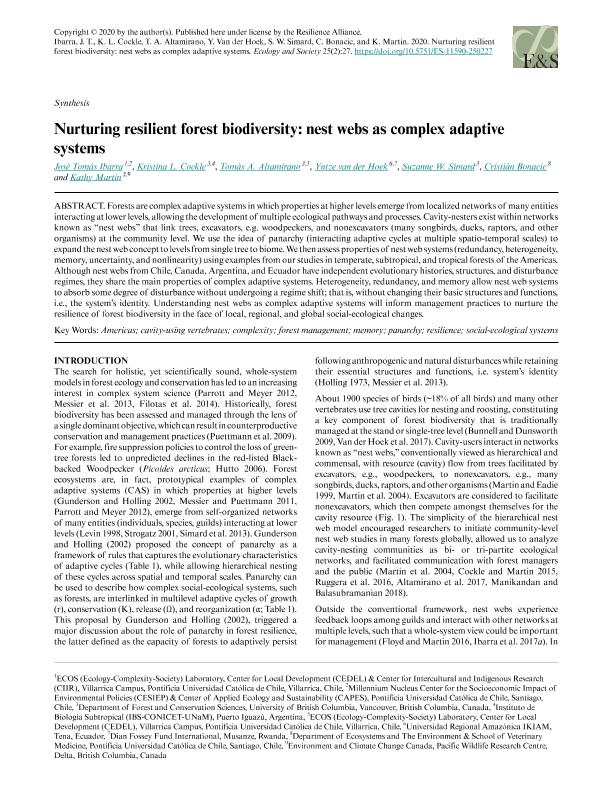Artículo
Nurturing resilient forest biodiversity: nest webs as complex adaptive systems
Ibarra Eliessetch, José Tomás; Cockle, Kristina Louise ; Altamirano, Tomás A.; Van der Hoek, Yntze; Simard, Suzanne W.; Bonacic, Cristián; Martin, Kathy
; Altamirano, Tomás A.; Van der Hoek, Yntze; Simard, Suzanne W.; Bonacic, Cristián; Martin, Kathy
 ; Altamirano, Tomás A.; Van der Hoek, Yntze; Simard, Suzanne W.; Bonacic, Cristián; Martin, Kathy
; Altamirano, Tomás A.; Van der Hoek, Yntze; Simard, Suzanne W.; Bonacic, Cristián; Martin, Kathy
Fecha de publicación:
06/2020
Editorial:
Resilience Alliance
Revista:
Ecology and Society
ISSN:
1708-3087
e-ISSN:
1708-3087
Idioma:
Inglés
Tipo de recurso:
Artículo publicado
Clasificación temática:
Resumen
Forests are complex adaptive systems in which properties at higher levels emerge from localized networks of many entities interacting at lower levels, allowing the development of multiple ecological pathways and processes. Cavity-nesters exist within networks known as “nest webs” that link trees, excavators, e.g. woodpeckers, and nonexcavators (many songbirds, ducks, raptors, and other organisms) at the community level. We use the idea of panarchy (interacting adaptive cycles at multiple spatio-temporal scales) to expand the nest web concept to levels from single tree to biome. We then assess properties of nest web systems (redundancy, heterogeneity, memory, uncertainty, and nonlinearity) using examples from our studies in temperate, subtropical, and tropical forests of the Americas. Although nest webs from Chile, Canada, Argentina, and Ecuador have independent evolutionary histories, structures, and disturbance regimes, they share the main properties of complex adaptive systems. Heterogeneity, redundancy, and memory allow nest web systems to absorb some degree of disturbance without undergoing a regime shift; that is, without changing their basic structures and functions, i.e., the system’s identity. Understanding nest webs as complex adaptive systems will inform management practices to nurture the resilience of forest biodiversity in the face of local, regional, and global social-ecological changes.
Archivos asociados
Licencia
Identificadores
Colecciones
Articulos(IBS)
Articulos de INSTITUTO DE BIOLOGIA SUBTROPICAL
Articulos de INSTITUTO DE BIOLOGIA SUBTROPICAL
Citación
Ibarra Eliessetch, José Tomás; Cockle, Kristina Louise; Altamirano, Tomás A.; Van der Hoek, Yntze; Simard, Suzanne W.; et al.; Nurturing resilient forest biodiversity: nest webs as complex adaptive systems; Resilience Alliance; Ecology and Society; 25; 2; 6-2020; 1-11
Compartir
Altmétricas



